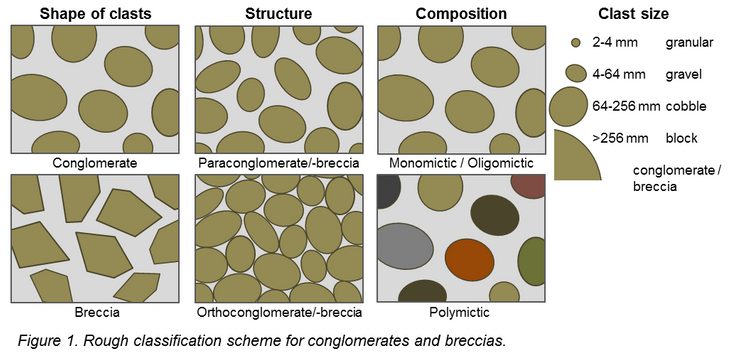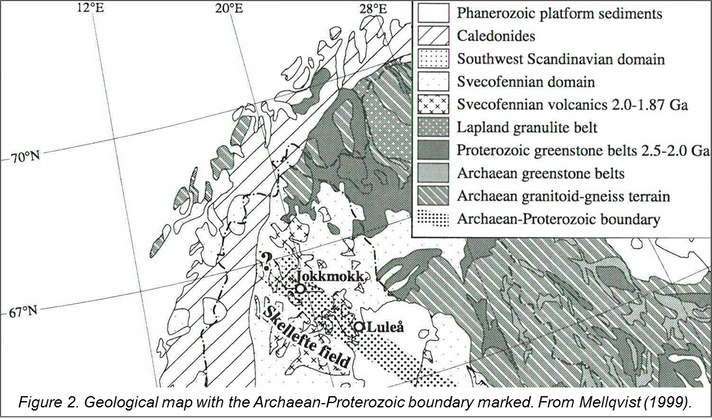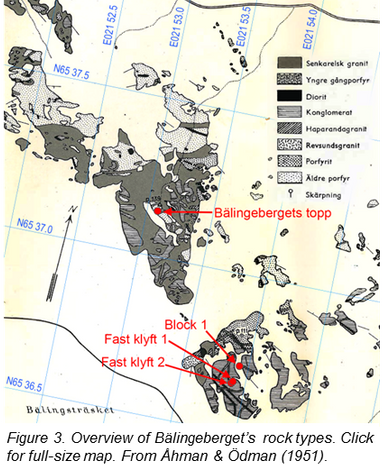Clastic classification at Bälingeberget - GC6RX1J
Bälingeberget (the Bälinge mountain) is a well known geologically interesting area where you can find shingle beaches and other post-glacial leavings. Perhaps less well known is that the area has also played a role in the interpretation of the geological evolution of Norrbotten, which will consequently constitute the topic of this Earth Cache.
Clastic rocks
A clastic rock is composed of so-called clasts (rock fragments) >2 mm in size, which are held together by a matrix of surrounding material (similar to cement or mortar). Examples of clastic rocks are conglomerates and breccia which consist of rock fragments, and sand stone which consists of grains of sand. Epiclastic rocks have been created by weathering and sedimentation (e.g. in a stream), while pyroclastic rocks have been created by volcanic activity.
Classification
Clastic rocks can be broadly classified based on a number of general characteristics (see also Figure 1 below).
Shape of clasts:
In a conglomerate the clasts are rounded (due to weathering processes and erosion), in a breccia they are more angular.
Structure:
If the clasts touch each other it is called clast-supported or orthoconglomerate/-breccia. If the clasts instead are suspended ("floating") in the surrounding matrix material it is called matrix supported or paraconglomerate/-breccia.
Composition:
If the clasts are made up of a single type of mineral or rock the conglomerate/breccia is called monomictic or oligomictic, if the clasts include several different rock types it is called polymictic.
Clast size:
Based on the dominant size of the clasts, the rock is galled a granular (2-4 mm), gravel (4-64 mm), cobble (64-256 mm) or block (> 256 mm) conglomerate/breccia.
The Bälinge “conglomerate”
Somewhere in Norrbotten the so-called Archaean-Proterozoic palaeoboundary can be found, separating the oldest rocks (Archean) in the northeast from the younger (Proterozoic) in the southwest (Figure 2). The Svecofennian rocks were deposited on the Archaean rock about 1.8-1.9 billion years ago, and include many different types of rocks. A number of conglomerate formations have been important in the continued age determination – including the Vargfors, Ledfat and Pite conglomerates, which belong to the younger Svecofennian rocks. Also on Bälingeberget conglomerate like formations have been identified, and discussed in the academic literature.
Åhman and Ödman (1951) described the Bälinge “conglomerate” as containing abundant amounts of balls, dominated by Haparanda granite. The absence of layered, ball-free deposits was interpreted as being the result of calm deposition, probably along a coastline without noticeable currents in the water. With an interpretation as epiclastic (sedimentary) conglomerate the formation would be younger than the surrounding Haparanda granite, and was regarded as very young compared to the dominant rock types in the area, which at the time probably gave rise to some concern amongst the geologists. The formation was used as a stratigraphic age marker together with the other aforementioned conglomerate formations, and came to define the “upper svecofennium” in the area.
The rock was investigated further by Wikström et al. (1996). From the refined analyzes it was concluded that the Bälinge “conglomerate” can’t possibly be an epiclastic sediment, which meant it also must be dismissed as stratigraphic age marker. The rock was instead described as pyroclastic, more specific of the type “magmatic, hydraulic breccia”, which was produced through interactions between different magmas. A main driving force in the formation was injection of hot mafic melts into the magma chamber, which caused severe overheating and subsequent explosive development. The rounding of the fragments has thus not been achieved by weathering and sedimentation in streams, but rather by erosion due to movements in the magma chamber.
EarthCache
Send the answers to the questions below to CO (Swedish or English). You can log the EarthCache immediately, without waiting for approval. If something is amiss, I’ll contact you.
- Examine either a section of solid rock or a block where the clastic rock is clearly visible (e.g. the EarthCache coordinate or right outside the Vikberg cottage). Describe the shape and size of the clasts, as well as the look of the matrix.
- Based on the section on classification above and your observations at the site, how would you like to classify the clastic rock on the site? Motivate your answer!
- (Optional) Use the map in Figure 3 as guidance to find an area of visible conglomerate/breccia (or a block) that isn’t already in the waypoint list of known observations or in the marked map. Anywhere on Bälingeberget or Vikberget is ok. Post the coordinates together with a brief description of the observation in your log. Click here to get a full-size map.
- (Optional) Post a picture of you and/or your GPS at the site.
Sources
Lundqvist J m.fl. (2011), Sveriges geologi från urtid till nutid. Studentlitteratur.
Mellqvist C (1999), Proterozoic crustal growth along the Archaean continental margin in the Luleå and Jokkmokk areas, northern Sweden. Luleå tekniska universitet, doktorsavhandling no. 1999:24.
SGU (2000), Berggrundskartan 24L Luleå NO, SGU serie Ai nr 153.
Wikström A, Mellqvist C, Barbarin B (1996), The Bälinge conglomerate in northern Sweden reinterpreted as a magmatic, hydraulic breccia. Terra Nova. 8(2):166-172.
Åhman E, Ödman O (1951), Konglomeratet på Bälingsberget i Nederluleå s:n. SGU C523, Sveriges geologiska undersökning.


